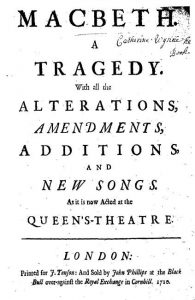Spring 2023: Traces of Macbeth: A Study of Text Reuse
Table of Contents
Background
Only some of Shakespeare’s works were published during his lifetime. After Shakespeare’s death, his fellow actors Heminge and Condell collected and edited Shakespeare’s works, and the compilation was then printed by Jaggard and published by Blount in 1623 (Smith, 2012; Murphy, 2003). This collection became known as the First Folio, and it included thirty-six plays of which eighteen had not been published prior to this, including Macbeth which was written circa 1606 (Smith, 2012; Murphy, 2003). Folio refers to the format of the book and this format was usually reserved for works of serious nature such as historical, theological, and topographical works prior to the First Folio, only one playwright had published their works in this format (Smith, 2012). During the course of the 17th century, newer editions of the First Folio were published and similarly to the First Folio, they also appeared in folio format. The newer editions were published in 1632, 1663, and 1685 (Murphy, 2003; Walsh, 2012). The second, third, and fourth Folios were minimally edited, mostly differing from the first in minor corrections, modernized spelling, and the inevitable transmission of mistakes (Walsh, 2012).

The first Macbeth in Octavo format was copied from the fourth Folio and published in 1709 by the House of Tonson with Nicholas Rowe as the editor (Walsh, 2012). Between 1707 and 1709, Jacob Tonson acquired rights to a large number of works authored by Shakespeare, which made him “the leading holder of Shakespeare’s textual property” (Walsh, 2012). The passage of the Copyright Act of 1710 enabled Tonson to hold exclusive rights to publish the playwright’s works, though only for fourteen years, which, as Walsh (2012) explains, heavily impacted how Shakespeare was published during the century. Following the death of Jacob Tonson I circa 1736, his successor(s) sought to maintain the Tonson house’s key role in Shakespearean publishing.
The 18th century was pivotal in making Shakespeare more widely available and in expanding the repertory of notable plays. According to Dugas, the printing of Shakespeare’s works started to have an impact on which plays were available in theaters after the 1730s (Dugas, 2006). During the mid-1730s the Tonson House’s monopoly in Shakespearean publishing was challenged most notably by Robert Walker (Dugas, 2006). Walker’s weapon of choice was to flood the market with very cheap single editions of all of Shakespeare’s plays, to which Tonson replied by publishing individual editions of all the plays at an even lower price and higher volume. As a result of this price war, Shakespeare became available to an even wider audience and the selection of Shakespeare’s plays that were performed also increased, including plays that had not been performed previously (Dugas, 2006). During the latter half of the century, Shakespeare’s significance as a playwright increased and his plays were the most performed in England at the end of the century. A second turning point occurred in 1772, when after the deaths of Jacob Tonson III and his brother Richard, Tonson’s copyrights passed to the Rivington publishing house. Additionally, in 1774, the decision of the Lords in the Donaldson vs. Becket case abolished any perpetual copyright in common law, further eroding the power of the London booksellers and opening the publishing market.

The editing of Shakespeare’s plays also evolved during the course of the 18th century. For a majority of the century most editors followed the method of textus receptus, that is, they copied a previous edition of the plays, adding both amendments and errors. Theobald’s 1733 collected plays were the first edition to justify the amendments to the text and thus it became one of the most successful of the century with multiple reprints. Moreover, the Tonson House published jointly with other publishers a collection of Shakespeare’s plays in 1765 which was edited by Samuel Johnson, the author of the Dictionary of the English Language, and this constituted the first variorum, Shakespeare. Edward Capell’s edition, published in 1768, strayed radically from the textus receptus tradition. He produced a critical text that relied on the most authoritative Quartos or Folios. Furthermore, the most exhaustive variorum of the late 18th century is Edmond Malone’s version, which was published in 1790. According to Walsh, Malone in his search for “the most authentick copies”, emphasized the importance of Quartos as textual sources (2012, p. 34).
In order to analyze how Macbeth was reused, we will next provide some context about the play. Macbeth is loosely based on Holinshed’s version of an 11th-century Scottish ruler, but the events described in Holinshed’s Chronicles span over 17 years while the events of Macbeth seem to extend over a period of a few months (Shaughnessy, 2011). To summarize, the play portrays the story of Macbeth: how he becomes the king of Scotland and what events lead to his downfall. The play discussed topics such as prophecies, assassination, and insurrection, and the characters of Macbeth also include witches. The play has been referred to by several different names, including Macbeth and The Tragedy of Macbeth. Within the theater industry, people however avoided using the word “Macbeth” due to the superstitious belief that the play was cursed by witches from whom Shakespeare was thought to have stolen the spells for the play (Royal Shakespeare Company, 2019). One of the alternative titles they used was The Scottish Play.
